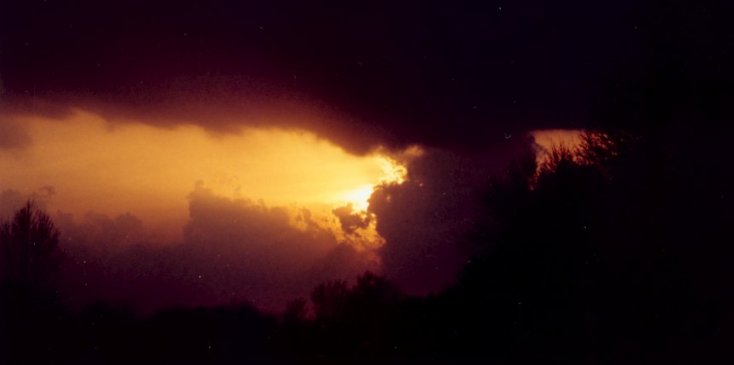SKYLIGHTS

Photo of the Week..Stormy sunset.
Astronomy news for the week starting Friday, March 1, 2002.
The early part of the week finds the Moon waning through its
gibbous phase as it heads toward third quarter on Tuesday the 5th.
It thereafter fades as a waning crescent. With the Sun approaching
the Vernal Equinox in Pisces, this third quarter will be
one of the two lowest of the year, as the Moon will be passing near
the Scorpius-Sagittarius border. The next one, which takes place
about two weeks after the equinox, will be equally low.
In early February, Saturn, still in Taurus, ceased retrograde and
began once again to move to the east against the starry background.
Now it is Jupiter's turn. Shining brilliantly in Gemini, the giant planet will
become "stationary" on Friday, March 1. Coincidentally, Jupiter is
now near its highest possible northerly position. About 6 degrees
to the east of the summer solstice, the planet is 23 degrees 17
minutes north of the celestial equator. It will "max out" on March
13 at 23 degrees 27 minutes and will then slowly move south.
Northerners will not see it so high -- or those in the southern
hemisphere so low -- for another 12 years. Jupiter is now
circumpolar (never setting) north of the Arctic Circle and is
invisible, below the horizon, south of the Antarctic Circle.
Mars, moving rather dramatically to the north and east, has just
passed across the boundary from Pisces into Aries. Though the Sun is catching up with it, the
northerly trek keeps the planet from setting much earlier each
night, and it is still up until almost 10 PM, though far away and
not much of a sight in a telescope.
Orion is now at its early-evening
peak. The great constellation, one of the most recognizable in the
sky, appears to the meridian to the south around 7 PM, about the
time twilight ends. As spring approaches, the Hunter will move
ever so gradually into the southwest, eventually to be lost to the
Sun in late April. The constellation is one of the few whose stars
are not just randomly distributed, but actually have some relation
to one another. Much of the constellation is a loose, expanding,
"association" of recently-born hot massive stars, which is what
gives the figure its bluish sparkle. The belt stars (Mintaka, Alnilam, Alnitak), Rigel, Saiph, and Meissa all belong to the "Orion OB1
Association" along with many others that include Sigma and the
stars of the famed Orion Nebula. Scorpius, who in mythology killed
Orion, is oddly similar, most of its stars part of a giant
association. Then there are the constellations made of clusters.
The Hyades forms the head of Taurus the Bull, Coma Berenices is made mostly of
cluster stars, and the middle five stars of the Big Dipper of Ursa Major, now climbing the northeastern sky, are all
members of the same group.







